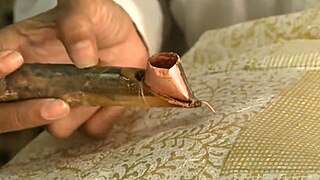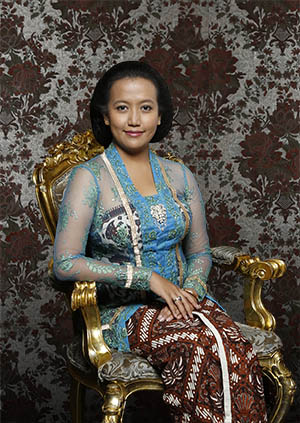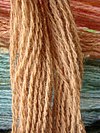
Batik is a dyeing technique using wax resist. The term is also used to describe patterned textiles created with that technique. Batik is made by drawing or stamping wax on a cloth to prevent colour absorption during the dyeing process. This creates a patterned negative when the wax is removed from the dyed cloth. Artisans may create intricate coloured patterns with multiple cycles of wax application and dyeing. Patterns and motifs vary widely even within countries. Some pattern hold symbolic significance and are used only in certain occasions, while others were created to satisfy market demand and fashion trends.

Canting, Canṭing, Canthing, or Chanting is a traditional Javanese tool to apply the malam in the original Javan Batik-making process, more precisely for the Batik Tulis type. Traditionally, the Canting consists of metal-based container for wax with small pipe spout and bamboo handle, made of copper, bronze, zinc or iron material, however modern version might use teflon.

A sarong or a sarung is a large tube or length of fabric, often wrapped around the waist, worn in Southeast Asia, South Asia, Western Asia, Northern Africa, East Africa, West Africa, and on many Pacific islands. The fabric often employs woven plaid or checkered patterns or may be brightly colored by means of batik or ikat dyeing. Many modern sarongs have printed designs, often depicting animals or plants. Different types of sarongs are worn in different places in the world, notably the lungi in the Indian subcontinent and the izaar in the Arabian Peninsula.

The culture of Indonesia has been shaped by the interplay of indigenous customs and diverse foreign influences. With over 1,300 distinct ethnic groups, including significant Austronesian and Melanesian cultures, contributing to its rich traditions, languages, and customs, Indonesia is a melting pot of diversity. Positioned along ancient trade routes between the Far East, South Asia, and the Middle East, the country has absorbed cultural practices influenced by Hinduism, Buddhism, Confucianism, Islam, and Christianity. These influences have created a complex cultural tapestry that often differs from the original indigenous cultures.

The palmette is a motif in decorative art which, in its most characteristic expression, resembles the fan-shaped leaves of a palm tree. It has a far-reaching history, originating in ancient Egypt with a subsequent development through the art of most of Eurasia, often in forms that bear relatively little resemblance to the original. In ancient Greek and Roman uses it is also known as the anthemion. It is found in most artistic media, but especially as an architectural ornament, whether carved or painted, and painted on ceramics. It is very often a component of the design of a frieze or border. The complex evolution of the palmette was first traced by Alois Riegl in his Stilfragen of 1893. The half-palmette, bisected vertically, is also a very common motif, found in many mutated and vestigial forms, and especially important in the development of plant-based scroll ornament.

A kebaya is an upper garment traditionally worn by women in Southeast Asia, notably in Brunei, Indonesia, Malaysia, Singapore, and Southern Thailand. It is also worn in parts of southern Philippines

Nagasari is a traditional Indonesia steamed cake, originating from Javanese cuisine, made of rice flour, coconut milk and sugar, filled with a slice of banana and wrapped in banana leaves.

The tradition of egg decoration in Slavic cultures originated in pagan times, and was transformed by the process of religious syncretism into the Christian Easter egg. Over time, many new techniques were added. Some versions of these decorated eggs have retained their pagan symbolism, while others have added Christian symbols and motifs.

Peltophorum pterocarpum is a species of Peltophorum, native to tropical southeastern Asia and a popular ornamental tree grown around the world.

Taman Sari Water Castle, also known as Taman Sari, is the site of a former royal garden of the Sultanate of Yogyakarta. It is located about 2 km south within the grounds of the Kraton, Yogyakarta, Indonesia. Built in the mid-18th century, the Taman Sari had multiple functions, such as a resting area, a workshop, a meditation area, a defense area, and a hiding place.

The Purna Bhakti Pertiwi Museum, is a history museum specialized on the life of Suharto, the former second president of Indonesia and a powerful political figure in modern Indonesian history. It is located in Taman Mini Indonesia Indah (TMII), Jakarta, Indonesia. The museum houses and displays the large amount of Suharto's collections; mostly valuable objects, artworks and souvenirs, received from various world leaders and Indonesian people, accumulated during the 32 years of his administration in Indonesia. The museum is a modern building designed with the shapes of tumpeng, a traditional Javanese cone-shaped rice dish which symbolizes gratitude.

The national costume of Indonesia is the national attire that represents the Republic of Indonesia. It is derived from Indonesian culture and Indonesian traditional textile traditions. Today the most widely recognized Indonesian national attires include batik and kebaya, although originally those attires mainly belong within the island of Java and Bali, most prominently within Javanese, Sundanese and Balinese culture. Since Java has been the political and population center of Indonesia, folk attire from the island has become elevated into national status.
An overlapping circles grid is a geometric pattern of repeating, overlapping circles of an equal radius in two-dimensional space. Commonly, designs are based on circles centered on triangles or on the square lattice pattern of points.

The Great Mosque of Surakarta is an 18th-century Javanese mosque in Surakarta, Central Java, Indonesia. It is the royal mosque of the Surakarta Sunanate.

National symbols are the sacred attributes for Ukrainian people. In Ukrainian graphics there exist a number of symbols and images from national songs, legends. Such symbols and imagery are used in national customs and rituals. They are reproduced in embroidery on national costumes, ritual cloth—rushnyks, painted on crockery, in forged products, in carving, in bas-relief house decoration, in hearth painting, pottery, engraving and also in Ukrainian traditional Easter eggs—pysanky.

Parang batik is one of the oldest Indonesian batik motifs. Parang comes from the Javanese word Pereng which means slope. Parang depicts a diagonal line descending from high to low. The arrangement of the S motifs intertwining unbroken symbolizes continuity. The basic shape of the letter S is taken from the ocean waves which depict a spirit that never goes out.

Tujuh rupa batik is one of the Indonesian batik motifs originating from Pekalongan, Central Java. This tujuh rupa batik motif is very thick with natural nuances. In general, tujuh rupa batik displays animal or plant motifs. The motifs are taken from various mixtures of local culture and Chinese ethnicity. Because, in the past, Pekalongan was a transit point for traders from various countries. Thus, it is this cultural acculturation that makes Pekalongan batik unique to nature, especially the jlamprang motif, the bouquetan motif, the moonlight motif, the cement motif, the pisan bali motif and the lung-lungan motif.

The Majapahit flagand emblem refers to the royal colors and symbols used to represent the Majapahit empire. However, the nature of how the colors and the symbols were used and represented is still a subject of study and disagreement among historians.
Indonesian batik patterns are coloured patterns on cloth made by the resist-dyeing technique of batik. The patterns are often associated with a particular city or region, and may have a symbolic meaning there.

Batik plays multiple roles in the culture of Indonesia. The wax resist-dyeing technique has been used for centuries in Java, and has been adopted in varying forms in other parts of the country. Java is home to several batik museums.
























